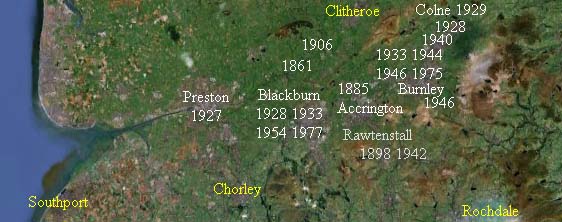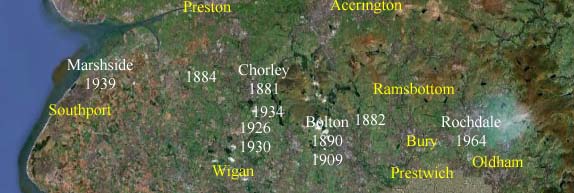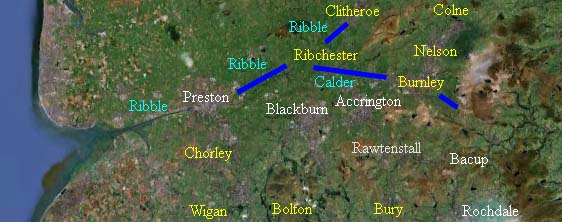- Related pages:
- Regional accents
- Rhoticity
- Rhoticity in Lancashire: Liverpool to Manchester
- Rhoticity in Lancashire: Southport to Rochdale
- This page: Rhoticity in Lancashire: Preston to Colne
- Rhoticity in Lancashire: Lancaster to Carnforth
- Rhoticity
- Regional accents
This page reports Area C (Preston, Blackburn, Accrington, Rawtenstall, Burnley, Colne). Briefly, the sound examples are taken from the British Library online collection (from the Leeds Survey of English Dialects, the Berliner Lautarchiv, and the BBC). Figure 1 shows the birth places and birth years of the informants.
 |
Figure 1. Map of Area C (Preston to Colne) showing the places and years of birth of the informants (white) and other places (yellow). Satellite map source: GoogleEarth. |
Area C is immediately north of Area B (Southport to Rochdale), extending inland from Preston, near the estuary of the River Ribble in the west, past Blackburn and Burnley, to Colne in the east. For reference, Fig. 2 is included from Part 2, showing Area B.
 |
Figure 2. For reference, map of Area B (Southport to Rochdale), which is immediately south of Area C. Satellite map source: GoogleEarth. |
John Wells (1982, Accents of English vol 2, CUP, p. 368) reported that any residual urban rhoticism is located in Rochdale and Accrington. We’ve already seen Rochdale in part 2, now we have Accrington. More recently, William Barras (2010, The Sociophonology of Rhoticity and r-Sandhi in East Lancashire English, PhD thesis, University of Edinburgh)
studied changing rhoticity from the Manchester district of Prestwich, directly northwards along the Irwell valley, passing Bury and Ramsbottom, to Haslingden and Accrington, finding progressively more rhoticity along that route (Fig. 2). Strikingly, he found the Rawtenstall area had the most persistent rhoticity, while Accrington had slightly less. Consequently, more rhoticity should be expected in the Accrington-Rawtenstall area, and less further away.
As expected, the distribution of recordings offered online at the British Library is uneven, depending on what happens to be available. It turned out that the best coverage was from Blackburn and Burnley, with fewer examples from elsewhere in both time and place. These informants were grouped as follows:
- One group stood out as being completely non-rhotic, eight informants with births ranging from the 1920s to the 1970s, from Burnley to Colne in the NE corner of Area C.
- There were two informants (born in the 1860s and around 1900) from the Ribchester neighbourhood, just north of Blackburn but in the Ribble valley, geographically separate, and oriented towards Clitheroe, further north again. The older informant was rhotic and the younger partially rhotic. This suggests a peripheral area that was becoming nonrhotic by the end of the 19th century, possibly in phase with the Burnley-Colne group.
- There was one informant from Preston, rhotic, born in the 1920s, who is included here with rhotic informants from Blackburn, (born in the 1920s, 1930s and 1950s). One Blackburn informant born in the 1970s was nonrhotic, suggesting that recent generations are becoming nonrhotic.
- Finally, there were just three informants from the Accrington – Rawtenstall area, two born in the 19th century, and one born in the 1940s. All were rhotic. There are no younger examples to demonstrate Barras’ finding that recent generations were still largely rhotic, more so in Rawtenstall.
For each set of words in the sound examples below, speakers are ordered by age, from older to younger.
Group 1: Burnley-Brierfield-Nelson-Barrowford-Colne
These examples are all nonrhotic (with no indication of when the local population was rhotic, possibly towards the end of the 19th century like Group 2 from around Ribchester). Of the eight informants, two were born in the 1920s, one in the 1930s, three in the 1940s, one in the 1960s, one in the 1970s.
Listen to nonrhotic examples from the Burnley-Colne area:
Example 1: nonrhotic NORTH vowels
Note [ɔə] in the earlier examples, [ɔ:] in the later examples.
fo(r)d, boa(r)ds, cou(r)se, befo(r)e, mo(r)ning, fou(r)pence, unfo(r)tunately,
no(r)mal, co(r)ners, mo(r)ning
Example 2: nonrhotic START vowels
ya(r)d, ma(r)velous, ma(r)bles, da(r)k, fa(r)m, sta(r)t
Example 3: nonrhotic NURSE vowels
Bu(r)nley, ea(r)ly, He(r)be(r)t, ci(r)cle, supe(r)b, gi(r)ls, bi(r)thdays, wo(r)k
Example 4: nonrhotic SQUARE vowels
chai(r)s, downstai(r)s, ra(r)ely, sha(r)ed, ba(r)ely
Example 5: nonrhotic weak syllables
highe(r), conducto(r), cove(r)ed, boile(r), afte(r)noon, pictu(r)es, wonde(r)ful, rounde(r)s, bothe(r), whateve(r)
Group2. The Ribchester neighbourhood
One rhotic informant born in the 1860s (Example 6), and one partially rhotic informant born around 1900 (Example 7).
Listen to rhotic and partially rhotic examples from the Ribchester area:
Example 6: Fully rhotic. Rhotic NURSE and SQUARE vowels, and rhotic weak syllables
Burton’s, worked, worked, compare them, scraper, liver, theirselves
Example 7: Partially rhotic.
Rhotic NURSE, SQUARE, NORTH, POOR and STARTvowels;
nonrhotic START, FIRE and NEAR vowels; rhotic weak syllables; nonrhotic weak syllables.
weren’t, upstairs, course, horse, poor, hard; sca(r)let, fi(r)e, yea(r)s; boiler, colours, doctor; highe(r), unde(r)neath, mothe(r), olde(r)
Group 3: Preston and Blackburn
Rhotic informants born in the 1920s, 1930s and 1950s, and one nonrhotic informant born in the 1970s.
Listen to rhotic and nonrhotic examples from Preston and Blackburn:
Example 8: Rhotic NURSE and SQUARE vowels
work, turnip, thirty, permanently, certainly, first, person, squares,
Example 9: Rhotic NORTH and START vowels
sort, transported, four, corporation, nextdoor, or, hard, market
Example 10: Rhotic weak syllables
trousers, bowler hat, regular, customers, deliver, winter
Example 11: Nonrhotic NURSE and START vowels, nonrhotic weak syllables
wo(r)ds, pe(r)son, sta(r)ted, teenage(r)s
Group 4. Accrington-Rawtenstall area
Three rhotic informants, 2 born in the 19th century, one in the 1940s. No-one born in recent decades who might demonstrate continuing rhoticity, or first signs of nonrhoticity.
Listen to rhotic examples from Accrington and Rawtenstall:
Example 12: Rhotic NURSE and START vowels
were, Thursday, churn; are, marks, carcass, are, heart, farmers
Example 13: Rhotic NORTH
horns, corn, morning, door, warm
Example 14: Rhotic weak syllables
bigger, customers, summer, butter, cellar, shoulder, colour, farmers, trotters, rounders
Conclusion
 |
Figure 3. The island of 20th century rhoticity extending N and NW from Oldham and Rochdale, across the moors and industrial valleys (white text). |
Looking back over the whole of the 20th century, there seems to have been an island of rhoticity extending diagonally across the moors and industrial valleys from Oldham and Rochdale to Rawtenstall and Bacup, continuing to Accrington and Blackburn, and presumably ending around Preston (white text in Fig. 3). This island had gradually shrunk to Accrington-Rawtenstall by 2000, with the strongest rhoticity around Rawtenstall. It’s easy to look at the moors surrounding Rawtenstall, and start thinking of isolation as a preserving factor for rhoticity. Yet this area has hardly been isolated. There’s a good network of roads linking all neighbouring towns and villages. Distances are small, 10kms from Rawtenstall northwards to Accrington, barely 15kms south to Bury, and thence the whole of Manchester. Rawtenstall had a railway link south to Bury and into Manchester since 1846, extended from Bacup in 1852. Manchester lost its rhoticity by the 1870s, Bolton and Bury presumably soon after. Yet neither proximity or communications seemed to affect this island of rhoticity to the north and northwest. The last rhotic generation in Rochdale and Oldham, on the NE edge of Manchester, was probably before 1940, and in Blackburn perhaps by 1960. Rhotic generations were still reported in Accrington and Rawtenstall around 2000.
There’s a similar remarkable boundary between Accrington and Burnley, some 10kms apart. The whole industrialized and urbanized valley from Burnley to Colne seems to have become nonrhotic by around 1900, possibly spreading up the Calder valley from Ribchester. But neighbouring Accrington still remains fairly rhotic a hundred years later, notwithstanding the constant movement of people, raw materials, and goods among these busy places.
Top
©Sidney Wood and SWPhonetics, 1994-2024
___________________________________________________________________
